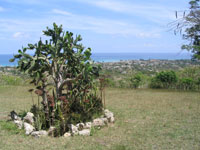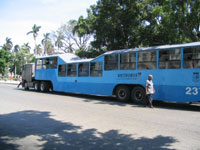Hotel Havana Libre, Sunday, April 10, 2005, 12:30 pm
Yesterday morning I had arranged to meet one of the women from the from the university, a very nice lady in her late 50s, who agreed to show me around the Vedado area and take me through some local markets.
Vedado is a beautiful residential neighbourhood with many mansions and villas dating back maybe 80 to 100 years or so. Before the revolution it was the neighbourhood where all the doctors, lawyers and business people lived, most of whom emigrated around the time of the Revolution. (Business people and professionals were expropriated as part of the Communist reorganization after the Revolution, as a result hundreds of thousands emigrated to the US, where there are substantial counter-revolutionary and Anti-Castro sentiments. The emigration of thousands of professionals in the early 60s apparently caused a real braindrain in the country).
We walked through the neighbourhood and visited local markets where they sell fruits, vegetables and meat. We saw local vegetables like yucca, malanga, boniato as well as fruits such as frutabomba (papaya), pineapple, mamey, mangos and others. Most of the meat that they sell in the markets is pork, and there is no refrigeration at all in the markets, although the meat is inspected by the government. It is forbidden to sell beef because beef officially is only to be used for milk production. Equally forbidden in local markets is seafood like lobsters since it is destined for big hotels and exports only, but we were approached by a couple of people who were selling both lobster and beef “debajo de la mesa” – under the table. This is one of the things in Cuba, many things are forbidden, but there is usually a way of working around it.
I was also taken to a special market hall where locals buy food at certain allocated times on their ration card. Food is still scarce in Cuba and every person receives a “libreta”which allocates a certain quota of basic foods such as butter, eggs, cooking oil, flower etc at very low prices. I was told that the monthly ration is 8 eggs per person and that if you want an extra carton of 30 eggs, they cost about $2 (CUC) (about Can$2.50), which is equivalent to about 1/10 of a person’s monthly salary. No wonder everybody tries to set up a little side business to obtain extra money, since survival in itself takes a lot of energy.
We also saw a local neighbourhood repair place, where they repair shoes with sowing machines that look like they are 100 years old. This is definitely a society where things are reused, mended, fixed and recycled time and time again, and it’s actually very refreshing to see a different way of living that contrasts so strongly with our modern way of living where we buy stuff we don’t need, just to throw it out later. Of course, the recycling here is due to necessity, but it does feel like there is a great appreciation for life here, not just consumer goods, despite all the difficulties.
This 2-hour walk was a great way of getting to know a little bit about the authentic Cuban lifestyle and some of the practical ways that Cubans try to make do in their daily lives.







